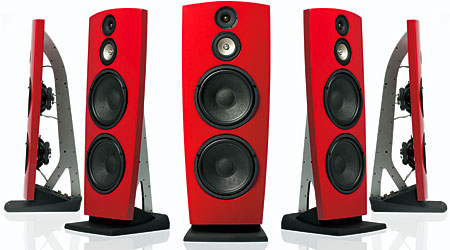| Columns Retired Columns & Blogs |
Jamo Reference R 907 loudspeaker
It was love at first sight when I saw a Jamo Reference R 909 loudspeaker in sparkling red lacquer on the floor of the 2007 Consumer Electronics Show. It made no sound, but it was beautiful, and I wanted it. It summoned up all my latent predilections for snazzy colors, striking shapes, and dipole speakers. But, as with many passing encounters in life, nothing came of it.

At the 2008 CES, another Jamo, the more modest Studio S 606, caught my eye, and I contacted Jamo USA. While I had Klipsch's then PR contact, Keith Claytor, on the line, I recalled the R 909 and thought, Hey, why not ask about the R 909's younger sister, the new Reference R 907? So when I went to a line show put on in Manhattan by the Klipsch Group, Jamo's parent company, and had a chance to see and hear the R 907 ($10,000/pair), I asked. They were delivered to my apartment the next day.
Had I made a rash decision? Well, the hotel demo room had had a marble floor, three hard, undecorated walls, and a fourth of glass. The only things warm, fuzzy, and absorbent had been one couch, one demo guy, and me. That room would have destroyed the sound of any decent speaker, and dipoles are more dependent than regular box speakers on a good balance of surface reflection, diffusion, and absorption. The R 907s had sounded thin and hard. So much for good looks, I thought. Feeling trapped but still curious, I accepted delivery.
You can look at dipoles in, um, two, er, three ways
1) A dipole speaker's elimination of a sealed box is a big plus; all drive-units are fundamentally dipoles, and all enclosures are resonant cavities capable of being excited by energy from the drivers. What this means is that, if the support for the drivers is sufficiently rigid and damped, an open panel won't contribute any spurious sound radiation to add to and compromise the output of the electrically driven diaphragms. It also means that because the diaphragms see an equal acoustic load on both sides, their movements are perfectly symmetrical. I've lived happily with Stax ELS-F81 and Apogee Duetta dipoles, and still remember their purity and precision in this regard.
2) A dipole speaker's radiation of sound results in a cancellation at the speaker's sides, top, and bottom, where the out-of-phase radiations from the drivers' front and back surfaces meet. This creates a null in the plane of the speaker for low frequencies whose wavelengths exceed the dimensions of the speaker's baffle. Consequently, dipoles are less likely to excite room modes in that plane, with a useful reduction in the influence of room acoustics on bass performance.
3) Finally, a dipole's radiation of sound to its rear, reflected from the front and sidewalls, can, when added to its frontal radiation, enhance the sense of spaciousness and greatly increase the size of the soundstage. It also contributes to the observation that the output of dipole speakers falls off with distance much less than does the output of box speakers. In other words, dipoles have a greater "throw."
The other side of dipoles
1) A large, flat panel is far more susceptible to flexing and vibration than the panels of a typical box. This is not a problem for the Reference R 907: its enclosure is made of curved panels of a 1.7"-thick, seven-layer laminate of MDF and glue, rigidly attached to a 53-lb cast-iron base and supported from base to top by a damped, laminated flying buttress, with bracing struts connecting it to the rear of the drivers.
2) A dipole's lateral cancellation of low frequencies drastically reduces the amount of bass energy reaching the listener. While this is often accepted as the price to be paid for the advantages of dipoles, it can be worked around. One way is to use an active filter and let the woofer amplifier compensate by boosting the speaker's output below the highest cancellation frequency, as in Siegfried Linkwitz's classic Audio Artistry designs. Another way to restore balance is to passively pad down the mid- and high-frequency drivers, but this results in very low overall sensitivity and a compromise in high-power output. (The Stax ELS-F81 had a sensitivity rating of only 83dB/2.83V/m but choked with high-power amps.) Jamo deals with this by using woofers that are substantially more sensitive than the norm (>100dB/2.83V/m at 200Hz), and more sensitive than the midrange and tweeter. This lets them passively filter and shape the woofer response to integrate with the mids at the system's overall sensitivity of 89dB/2.83V/m.
- Log in or register to post comments




































